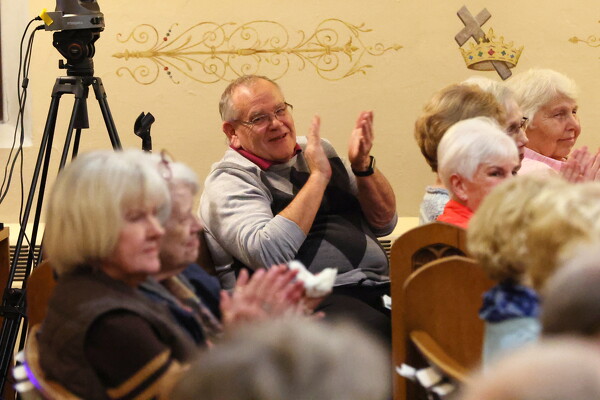
Valerie Boyer, Columbus, gives a presentation about the coded language of Negro Spirituals during the Underground Railroad during an Auglaize County Historical Society event at the St. Paul's United Church of Christ in St. Marys on Tuesday evening.
ST. MARYS - In honor of Black History Month, Valerie Boyer, an activist, musician and educator, discussed Negro spirituals, a type of religious folksong that enslaved people sang and their descendants still sing today.
About 100 people attended "Coded Language of Negro Spirituals during the Underground Railroad," an event hosted by the Auglaize County Historical Society. Attendees listened and learned about how the music worked as a stealthy form of resistance, with hidden messages coded within the hymns.
When someone who didn't need to know, such as a bounty hunter or master, heard the songs, they assumed the hymns were about heaven, scripture or biblical references in folklore, according to a press release about the event. They didn't know the songs were metaphors and often were direct discussions of liberation, seeking escape routes and planning resistance.
Boyer, the school and inclusive community programs coordinator at the Ohio History Connection, said the hymns were first documented in 1813 but were around long before. In late 17th-century Europe, particularly in Great Britain when the Reformation developed, Black people often didn't have access to literacy and couldn't read.
"People still gather in churches to worship and so they sing what are called 'meter hymns,'" Boyer said. "A meter hymn will be a leader who literally could play and could read the music and they would play through the lines, singing it or saying it."
The spirituals were "typically sung in a call and response form, with a leader improvising a line of text and a chorus of singers providing a solid refrain in unison," according to information for the Library of Congress.

Audience members clap in participation as Valerie Boyer teaches them about the hidden meaning of certain candences.
Boyer said during the Transatlantic Slave Trade, particularly North American chattel slavery, the goal was to erase Black identity. Some spirituals emerged as a response to that.
"The goal is to get enslaved Africans and Black folks and freedom seekers to see themselves as property, not as person," she said "A part of that unfortunately … used biblical lore. You have these people and they're learning these hymns and these Bible verses as what is supposed to be a way to keep them bound and a way to erase identity. But what is happening is that they are taking these songs … and they are singing them in what is traditional African or Black sound. They're using their music as a way of preserving culture in a very coded manner because it's only recognized by the people who are supposed to recognize it."
Negro spirituals are a form of Africanism, or something that is considered inherently African, Boyer explained. (Another example of this is the use of peppers and onions in African dishes because those crops were staples in West African countries and were brought over to America).
"Negro spirituals are a form of Africanism because it keeps music alive," Boyer said.
She said the hymns are also considered folklore, much like a piece of literature that is used by a culture or a subculture to make a point or convey meaning. Oftentimes, the hymns, like fables, weren't about just one topic.
The spirituals are of a blended culture, we're often used for keeping time, and had roots in "bush meetings," Boyer noted.
"Bush meetings (were for) people who are not allowed in the front, on the floor or in the pulpit of anyone's worship setting and so they start building their own buildings," Boyer said. "It literally meant meeting up somewhere in nature to get connected with the creator of nature, nature itself and self. It's a way to gather with some dignity on your own terms in a world and in a country that's doing its best to make sure that you have neither."
Boyer simplified the 17 types of spirituals into four categories: eschatological, or themes about heaven; soteriological, political themes; psychological, emotional themes; and instructional, or themes that tell the subject about how to navigate the Underground Railroad as they are seeking freedom.
Boyer broke down "Wade in the Water," a Negro spiritual published in 1901. The lyrics include "Wade in the water. God's gonna trouble the water."
"For someone who does not know the code and is not supposed to know the code, they hear you talking about a baptism," Boyer said. "For those who know the code, you know that most water groups at that time (that) people have access to often upstream lead north. You also know that when bounty hunters are searching on horse and on dog, the water has a way of desensitizing the smell. You wade in the water and God's gonna trouble it, as in you'll be protected."
Halfway through the presentation, attendees took a stab at deciphering a hymn.
Boyer showed a video in which her pastor sang, "Jesus the man I long to see/Please tell me where he is/Go down and search amongst the poor./Perhaps you will find him there/And if I find him, how will I know him from another man/He has salvation on his brow and victory in his hands."
The hymn, like many, has multiple and layered meanings.
"Historians debate about the eschatology of it because (it says) 'Jesus the man I long to see,'" Boyer said. "It talks about how he has salvation on his brow and victory in his hand, relating that to (when scripture says) when Christ comes in final victory and how majestic … that's supposed to look when the rapture comes."
She also said there some soteriological or social commentary.
"The song says 'Go down and search among the poor/Perhaps you'll find him there.' In this hymn, Jesus is not some super inaccessible, kingly deity (who) cannot be accessed. This Jesus is one who blends in with the poor; this Jesus is Jesus of the people. That's the political commentary. This is a Jesus (who) looks like us and looks the way the people look and feels the way the people feel."
She also said it is emotional and psychological, as evidenced by 'Please tell me where he is.'
"You don't say please or beg for something unless you got some big feelings about it."
The hymn is also instructional because "Jesus is a metaphor for a conductor or abolitionist," Boyer said.
"'Jesus, the man I long to see/Please tell me where he is' (can translate to) give me the instructions on how to get to the conductor/abolitionist here," she said. "'Go down and search amongst the poor/Perhaps you'll find them there.' So, he's amongst the people. 'And if I find him, how will I know him from another man?' (That means) I don't wanna get this abolitionist or conductor confused with somebody else. We need to be able to recognize them. 'He has salvation on his brow and victory in his hands.' 'Salvation on the brow' is often a metaphor used to (indicate) a soldier and/or fighter. There's a clear indication that this person is a fighter. 'Victory in his hands' is often a metaphor for a weapon because liberation is complicated, and more often than not, because it is not freely given, it is taken by force."
There are many such spirituals, Boyer noted, but because Black identity will not be erased, the hymns will remain for many years to come.
She is originally from Galveston, Texas, and has dedicated her life to empower and inspire. She graduated from Howard University and lives in Columbus.

